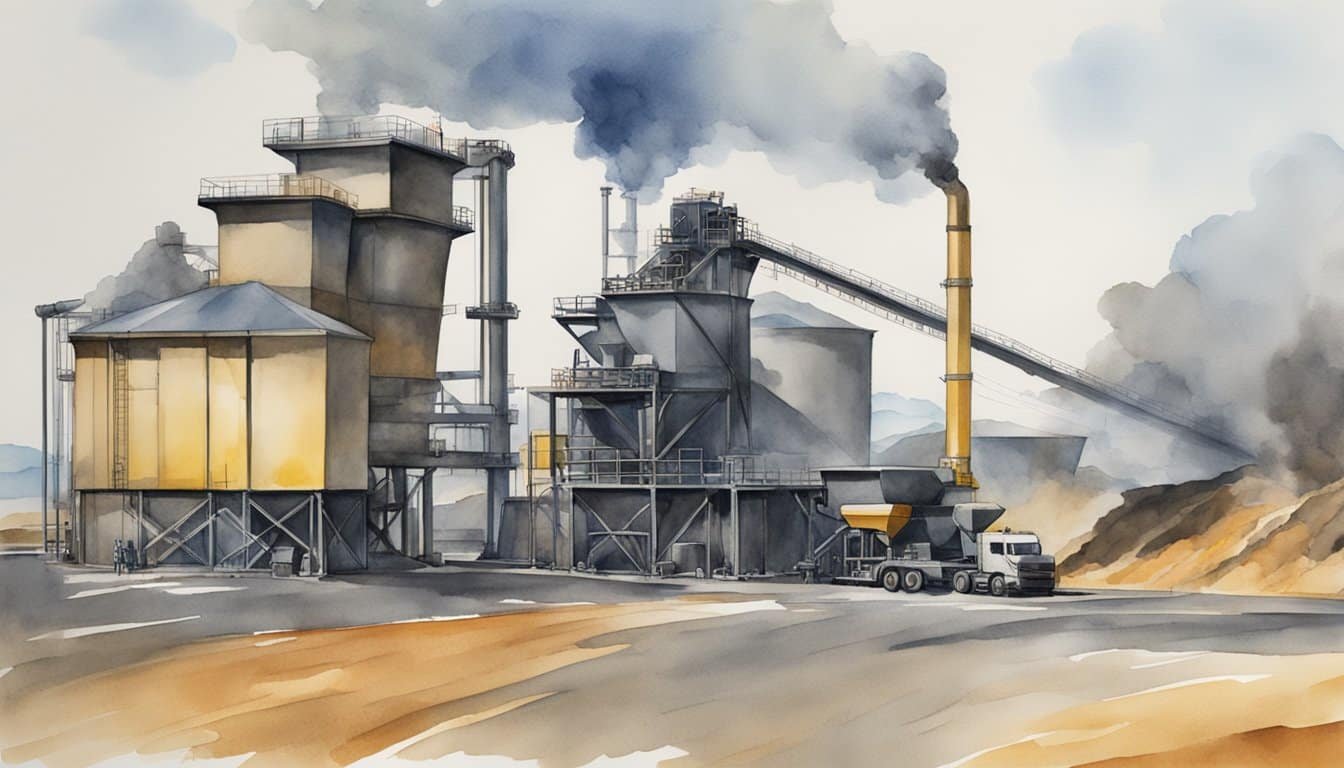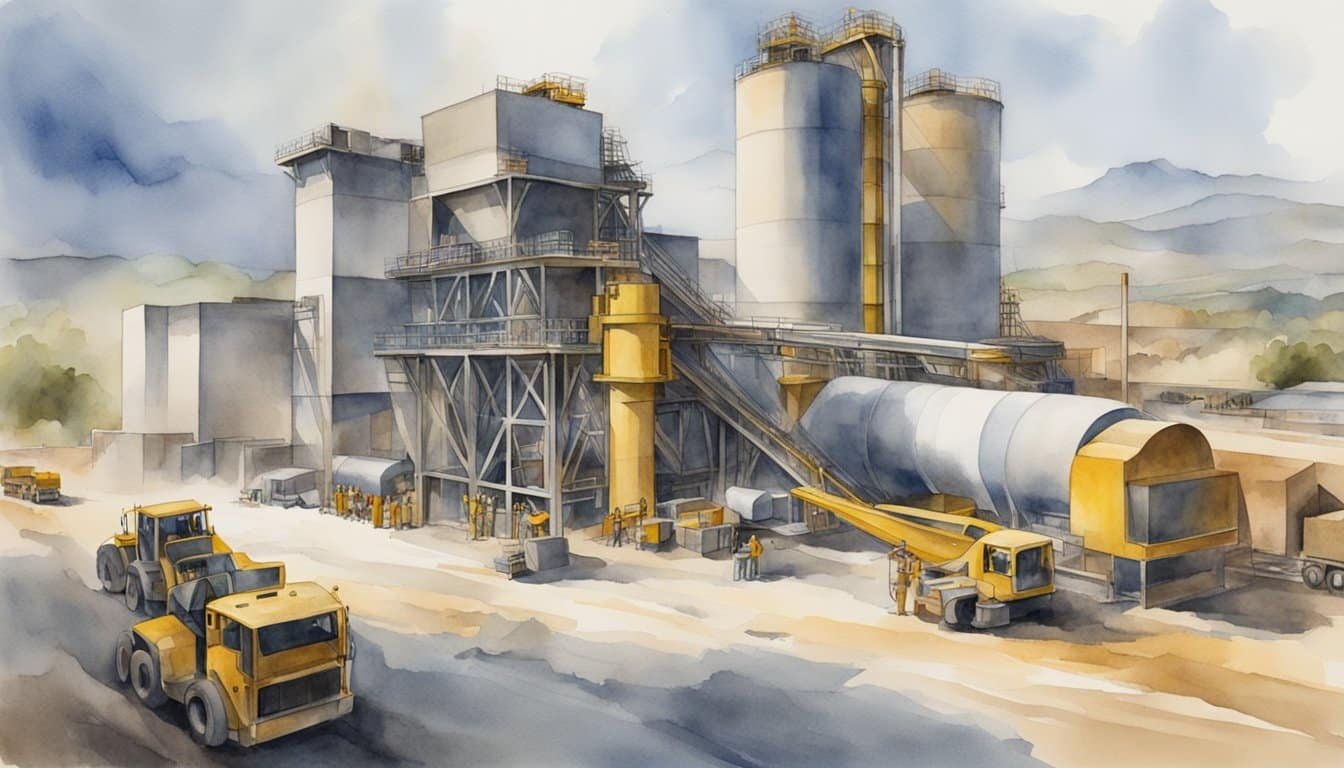Basics of Hot Mixing

Hot mixing is a vital process in construction that involves heating materials to create a durable and malleable product. It’s fascinating how simple materials transform into strong structures through a little heat and mixing.
Chemical Processes and Components
During hot mixing, materials like lime (calcium oxide) react with water in an exothermic reaction to form calcium hydroxide. This process releases heat, and when calcium hydroxide combines with carbon dioxide from the air, it creates calcium carbonate, reverting back to a solid state. As for cement, it typically comprises calcium, silicon, iron, and aluminum, which chemically combine through heat and energy to become the binder for concrete.
Hot Mixing Techniques
In hot mixing, aggregate materials like sand and gravel are mixed at high temperatures. Heat allows the mix to thoroughly combine and makes the asphalt or concrete more workable. For asphalt, the hot mix technique involves heating the aggregates before adding the bitumen, creating a uniform and viscous paving material that sets to form a solid, smooth surface once cooled.
Historical and Modern Use of Hot Mix Concrete

Hot mix concrete has traversed a long journey from the ancient world’s building techniques to modern day engineering marvels. Its evolution reveals how a mixture of simple materials can lead to the development of structures with great complexity and endurance.
Evolution From Ancient Mixes to Modern Usage
The use of concrete by the Romans laid down a blueprint for what would become one of the most significant building materials in human history. The ancient Romans were adept at creating a type of concrete, now often referred to as Roman concrete, which included a mix of volcanic ash and lime clasts. This blend was crucial to the construction of enduring structures like the Pantheon, with its still-standing concrete dome, one of the ancient world’s most famous architectural achievements. The ancient Roman technique involved using a hot mix to initiate a chemical reaction that increased the material’s strength, a practice that has piqued the interest of modern researchers and engineers.
Fast forward to contemporary times, and concrete is still at the center of structural and architectural advancements. Yet, today’s modern concrete differs vastly from its ancient counterpart. With the advent of Portland cement in the 19th century, the production of concrete underwent significant changes. Present-day concrete often includes modern cement as a binder, replacing the volcanic components used by the Romans. Recent developments have even seen the advent of 3D-printed concrete — going well beyond Vitruvius’ or Pliny’s ancient prescriptions and propelling the capabilities of construction into a new era.
Self-Healing Properties and Sustainability
One of the most notable properties of Roman concrete is its self-healing ability. When cracks form, the presence of certain materials in the mixture like lime can react with water, leading to a recrystallization that fills the gaps. Modern scientists and engineers are learning from this ancient Roman concrete to develop similar self-healing functionalities in today’s concrete, potentially improving its durability and longevity. Institutions like MIT, Harvard University, and laboratories in Italy and Switzerland have been key in this body of experiment.
Furthermore, sustainability has become a focal point in today’s concrete usage due to growing concerns over greenhouse gas emissions and carbon footprints. Given that the production of Portland cement contributes significantly to such emissions, finding alternatives has become critically important. The self-healing functionality of concrete not only presents potential maintenance and durability benefits but also impacts sustainability. This is because reducing the need for repairs and replacements can directly lower greenhouse gas outputs associated with construction activities. Thus, the bridge between Roman concrete techniques and modern methodologies might not only lead to stronger structures but also a greener planet.
Practical Applications and Advancements
Hot-mixing techniques in construction and materials science don’t just deliver stronger and more durable materials; they reshape how we think about the entire building process from cost to performance.
Construction Efficiency and Cost-Effectiveness
In the realm of construction, hot-mixing has proven to significantly streamline processes, leading to faster construction timelines. By integrating heat curing, which doesn’t always require special equipment, efficiency climbs, and the time from start to finish can see a remarkable decrease. The economic impact is just as impressive. Opting for heat-cured materials often means projects can be cost-effective, reducing costs in the long run by decreasing labor and energy expenditures.
Advancements in Testing and Material Science
Science takes center stage when improving the materials we use. Scientists, like Linda Seymour, have contributed to advancements in granulometry and concrete mix optimization. By experimenting with hot-mixing limestone and other aggregates, they’ve developed inclusions that can enhance mechanical properties and the overall pore structure of concrete. Italian and Swiss laboratories have found that these improvements not only increase compressive strength but also introduce self-healing properties to the material, combating common issues like cracks and seepage. With every test and tweak in the mixture, the result is a step forward in creating materials that stand the test of time – both structurally and environmentally.

